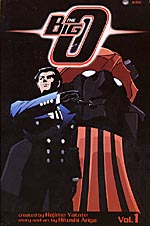 By Hitoshi Ariga
By Hitoshi Ariga
208 pages, black and white
Published by Viz
Sometimes all it takes is a catchy premise to score a new reader. Take The Big O: a book set in Paradigm City, where 40 years earlier everyone lost their memories. Now people use pieces of the forgotten past to forge the future. Sounds great, right? Well, just keep in mind that a good premise does not automatically equal a good final product. You’ve got to take advantage of that potential and really turn it into something special.
Roger Smith is a negotiator, called in by both police and private citizens to work out the details of rather dangerous situations. What no one realizes, though, is that he’s also the keeper of the Big O, a massive robot that he uses to smash through evil-doers. Can Roger Smith and the Big O bring peace and happiness to a city without memories?
Now, going into this I already knew that there was a Big O animated series that this is loosely based on. The back cover emphasized that this was an expansion of the original cartoons, though, and that in many ways The Big O Vol. 1 was a prequel to the tv show. So, I thought that I would be all set to read and enjoy this book. Wrong. Maybe I’d have a better feel for this if I’d watched the show, but the number of plot holes and jumps in logic are so huge you could drop all of Paradigm City inside of them. In the first story, terrorists seize a building called the Memory Repository, where thousands of memories are being stored. It turns out two of the terrorists are doing so because they’ve been promised by the main bad guy that he’ll give them their memories back, which are being stored here; at one point he even identifies which memories are theirs. All right, fair enough… but if everyone in this city has amnesia and all these memories are being stored in this building, why aren’t they giving the memories back to their rightful owners? You’re starting to see the problem with the plotting here, I hope. This whole volume of manga feels like you’re missing lots of vital pieces of information that somehow never made the transition from screen to page. Why does the chief of police call the Big O “Megadeus”? What the heck does the catch phrase, “Cast in the name of God ye not guilty” mean, and why does the Big O keep saying it? I hate to say it, but this is far too nonsensical to someone who hasn’t seen the tv show. (Maybe they’re equally in the dark, who knows?) Even when there’s a spark of something good—specifically the “Electric Bug” story in the middle of this book—there’s too much around it that has you scratching your head in bafflement.
Ariga’s art is a little better than his writing, thankfully. The problem is, we’ve seen it all before. Full of speed lines, superdeformed faces, and what could only be described as a stereotypical “anime face” on all of the characters, it feels less like actual drawings and more like tracings off of the tv screen. That’s not to say it’s bad, but it is lacking in originality. With such a wealth of manga being brought over from Japan these days, it’s distressing to see a new book that resembles what all the nay-sayers claim all manga looks like.
I really wanted to like The Big O Vol. 1, because I’d heard good things about the animated series, which apparently is doing very well these days on the Cartoon Network in North America. But this… well, in every way that Blood: The Last Vampire 2002 managed to stand on its own from the movie it was based off of, The Big O doesn’t. Perhaps the biggest crime of all, though, is in the final story of the first book we see what movie critic Roger Ebert calls the “idiot plot”—in order for the story to proceed, everyone involved has to suddenly act like an idiot. Ouch. If you’re a fan of the cartoon and thus can make more sense out of this than I (or merely have a deep abiding love for robots), you can find The Big O in stores everywhere.
Purchase Links: Amazon.com
